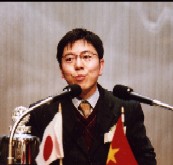��The Beauty of Song Ceramics�ɡ�
February 7, 2007
Mr. Jin Li-yan,
Manager,
Porcelain & Works of Art, China Guardian Auctions
 This special selection of Chinese ceramics is a fine illustration of the artistic achievements of ceramics manufacturing of the Song dynasty (960-1279). Although high-fired stone wares were made for almost two thousand years, it was during the Song period that technical production process was perfected allowing potters and artisans to concentrate on perfecting form and glaze. The result was an unprecedented refinement in form, perfect smoothness in glaze and texture and brilliance in colouration.
This special selection of Chinese ceramics is a fine illustration of the artistic achievements of ceramics manufacturing of the Song dynasty (960-1279). Although high-fired stone wares were made for almost two thousand years, it was during the Song period that technical production process was perfected allowing potters and artisans to concentrate on perfecting form and glaze. The result was an unprecedented refinement in form, perfect smoothness in glaze and texture and brilliance in colouration.
Song wares acquired an aesthetic appeal that became highly sought after by scholars, nobility and the imperial court, Japanese ceramics expert explains the spirit of Song ceramics as the ��Great Ultimate��, a phrase he adopts from the writing of the Southern Song neo-Confucianist Zhu Xi (1130-1200). For Zhu, it resolves all the phenomena of the universe into forms that, though simple within themselves the origins of everything. One cannot find a more appropriate description for Song ceramics. The purity of line and beauty of glaze has an aesthetic appeal that is universal and transcends time. Song ceramics have become the inspiration for generations of artists and craftsmen to this day.
1 Celadon
��Celadon ewer with lion mouth. 18.7cm high. Yao zhou kiln. 12th century. Cleveland Museum. (Left)
Celadon vase with incised peony flowers design. 16.7cm high. Yao zhou kiln. 12th century. Osaka Oriental Ceramic Museum.
��Celadon bowl with incised phoenix design. 15.7cm diam. Yao zhou kiln. 12th century. Tokyo National Museum.
��Celadon bowl. 26.1cm. diam. Guan kiln. 13th century. Tokyo National Museum.
��Celadon mallet vase with two phoenix handles. 26.6cm high. Long quan kiln. 12th century. Yomeibenko Collection.
2 White Porcelain
��Ying qing type glazed vase with incised peony flowers design. 22.5cm high. Jing de zhen kiln. 12th century. Private Collection.
��White glazed parrot form cup. 15.2cm wide. Southern kiln. 12th century. Private Collection.
��White glazed bowl with incised flowers design. 18.7cm diam. Ding kiln. 12th century. Tokyo National Museum.
��White glazed pillow. 20.8cm wide. Ding kiln. 12th century. Asian Art Museum of San Francisco
3 Other type��s ware
��Tenmoku tea bowl with oil spot. 12.2cm diam. Jian kiln. 13th century. Osaka Oriental Ceramic Museum.
��Meiping vase with sgraffito decoration of peony flower design. 40.2cm high. Ci zhou kiln. Esebenko Collection.
As ceramics expert notes, ��Song ceramics were made for nearly every taste and budget, and every level of society, and ranged from rough shipping containers to imperial tea bowls the aim was not factory-like series production of indistinguishable item. Variations made the kilns output unpredictable thus interesting. The grading of individual items was partly a matter of personal taste.��